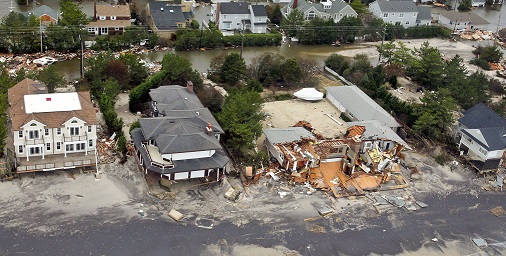Energy Innovation partners with the independent nonprofit Aspen Global Change Institute (AGCI) to provide climate and energy research updates. The research synopsis below comes from AGCI’s Emily Jack-Scott, and a full list of AGCI’s quarterly research updates covering recent climate change research on clean energy pathways is available online at https://www.agci.org/solutions/quarterly-research-reviews
It’s become a common phenomenon – an extreme event such as a hurricane, flood, drought, or exceptionally cold winter creates devastating impacts, and policymakers are left reeling over how to recover from such an event, and whether they should be planning for a future where extremes will be the “new abnormal.”
 A general sense exists that anthropogenic climate change is changing global weather patterns and events, but that general understanding doesn’t help inform decisions on the regional scale, and decision-makers are demanding reliable information about local conditions and future hazards.
A general sense exists that anthropogenic climate change is changing global weather patterns and events, but that general understanding doesn’t help inform decisions on the regional scale, and decision-makers are demanding reliable information about local conditions and future hazards.
An new approach by Otto et al. (2018) aims to address this need by marrying the latest attribution techniques with model projections to help understand whether an extreme event in a specific region was attributable to climate change, and if it will be more or less common in future for that specific area. The authors’ approach compares risk profiles for extreme events across time scales – past, present, and future – thus building confidence in observed trends, helping clarify underlying drivers of extreme events, or elucidating areas of uncertainty in observations, processes, or both. These results can be incredibly useful in the painful pauses that follow extreme events, when politicians are forced to grapple with how climate change is impacting their constituents’ lives, and what should be done to prepare for the future.
The authors illustrate their method’s value through four very different case studies: excessive flooding in Thailand (2010), an exceptionally cold winter in Peru (2013), extreme rainfall in Colombia (2006), and drought in Somalia (2010-11). These extreme events were chosen because they were highly impactful (each with high loss of life) and occurred in areas with skillful regional models.
The analysis uses three steps to provide information across timescales on detection, attribution, and projection of similar hazards in each region: 1) use the available observational record to detect trends; 2) test attribution of trends from the first step to climate change, natural variability, or a combination; and 3) assess future risks of such hazards through multiple model projections in both 1.5°C and 2°C future climate scenarios. For each event the authors report the projected return interval for similar extreme events – information that can directly inform decision making.

The authors found a higher risk of future flooding in Thailand, though they were unable to attribute the event to climate change (likely due to the limited observational record). In Peru’s cold snap, observations demonstrate declining extremes, and models project pronounced declines in future cold extremes – in fact, future 2°C scenario models suggest such an extreme may never happen again in the region. In Columbia’s extreme rainfall, no observational trend was found, and while models indicate a likely decrease in such events in future, the projection was not significant. Finally, in Somalia’s drought, no trend was found in the observational record, and the different models disagreed on whether such events will be more or less common in future, underscoring a lack in understanding on season-specific processes that were driving the drought.
The authors cede that the one issue with this past-present-future analysis is that past trends (which draw on a combination of observations and model results) cannot be directly compared to future projection results (model only results). However, great value still exists in considering past trends and attribution alongside future projections. If observed trends agree with future projections (as in Thailand and Peru), that validates our understanding of the event’s underlying drivers, and improves our ability to predict whether such extremes must be planned for more or less in future. Even when observed trends and projections do not agree (as in Colombia and Somalia), flagging where additional research is needed to understand the complexity of underlying processes driving regional extremes is still valuable.
This approach to assessing current and future risks of extreme events on a regional scale is new, but it holds immense promise. The approach provides a unique and relatively seamless means of contextualizing attribution and projection, which can either validate our understanding of extreme event drivers, or call attention to where additional processes understanding is needed. And ultimately, this kind of knowledge is invaluable to decision makers who need regionally-specific information on how to prepare for extreme events in a changing climate.
Otto, F.E., Philip, S., Kew, S., Li, S., King, A. and Cullen, H., (2018) Attributing high-impact extreme events across timescales—a case study of four different types of events. Climatic Change, 149(3-4), pp.399-412.
